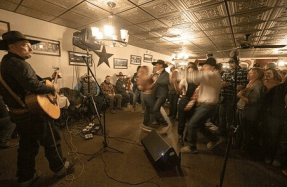PERMISSION TO POACH

ALONG THE EASTERN FOOTHILLS of Wyoming’s Absaroka Mountains, halfway between Crowheart and Dubois, a weathered buck-and-rail fence separates tribal land from public land. To the east lies the Wind River Reservation and the jurisdiction of tribal game warden Justin Friday. On a clear fall morning in 2020, Friday’s ATV zipped along a dusty two-track on the national forest side of the fence.
It had been a hot, dry summer. The East Fork of the Wind River was a narrow band of green, snaking through tangles of sagebrush and bunch-grass that, a few miles up, gave way to towering lodgepole forest.
“Up here is the reservation boundary,” Friday shouted over the engine. A sign on the tribal side read: WIND RIVER INDIAN RESERVATION CLOSED TO HUNTING, FISHING, TRAPPING AND TRESPASSING.
Friday was retracing the path of Matthew Harris, who would have hiked past the sign in October 2017. Harris, a special agent with the U.S. Bureau of Alcohol, Tobacco, Firearms and Explosives, worked at the agency’s satellite office in Lander and was out that day hunting.
Friday parked and hiked a short way uphill, over a break in the fence where wildlife often crossed. In a clearing, he found what was left of Harris’ kill after three years: the sun-bleached skeletal remains of a bull elk. Most of the animal’s ribcage and two femurs remained, but the skull and antlers — the parts a hunter might take to display at home — were gone.
According to the Shoshone and Arapaho Fish and Game Code, only Eastern Shoshone and Northern Arapaho tribal citizens with the proper permits and tags may hunt on the reservation. Harris met none of those requirements when, according to federal investigative reports obtained by High Country News, he aimed his .338 caliber rifle across the fence and fired twice at some elk.
If this story sounds familiar — a law enforcement officer downing an elk on the wrong side of the border between tribal land and a national forest in Wyoming — you’re probably thinking of Clayvin Herrera, a former Crow tribal game warden who made headlines asserting the tribe’s treaty right to hunt on the “unoccupied land of the United States.” Herrera was convicted of two misdemeanors for shooting elk in the Bighorn National Forest in 2014. The resulting legal battle went all the way to the U.S. Supreme Court, which, in 2019, decided in Herrera’s
You’re reading a preview, subscribe to read more.
Start your free 30 days





